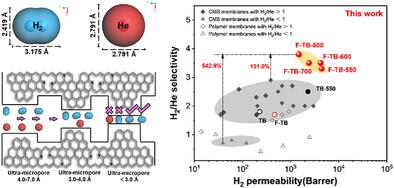Tuning Fluorination of Carbon Molecular Sieve Membranes with Enhanced Reverse-Selective Hydrogen Separation From Helium
IF 13
2区 材料科学
Q1 CHEMISTRY, MULTIDISCIPLINARY
引用次数: 0
Abstract
Membrane technology has been explored for separating helium from hydrogen in natural gas reservoirs, a process that remains extremely challenging due to the sub-Ångstrom size difference between H2 and He molecules. Reverse-selective H2/He separation membranes offer multiple advantages over conventional helium-selective membranes, which, however, suffer from low H2/He selectivity. To address this hurdle, a novel approach is proposed to tune the ultra-micropores of carbon molecular sieves (CMS) membranes through fluorination of the polymer precursor. By incorporating -CF3 units into the backbone of Tröger's base polymers, the microporosity of CMS is tailored and reverse-selective H2/He CMS membranes are deployed with remarkable separation performance, surpassing most reported membranes. These CMS membranes exhibit a H2 permeability of 1505.2 Barrer with a notable H2/He selectivity of 3.8. Barometric sorption tests reveal preferential sorption of H2 over He in the fluorinated CMS membranes, which also demonstrate a significantly higher H2/He diffusion selectivity compared to unfluorinated samples. Material studio calculations indicate that the “slim” hydrogen molecule penetrates ultra-micropores more readily than the spherical He molecule, thus achieving reverse H2/He selectivity. This design approach offers a promising pathway for developing molecularly sieving membranes to tackle the challenging helium separation from natural gas.

碳分子筛膜反选择性氢氦分离的调谐氟化
膜技术已经被用于从天然气储层中分离氦和氢,这一过程仍然非常具有挑战性,因为H2和He分子之间的大小差异小于-Ångstrom。与传统的氦选择膜相比,反选择性H2/He分离膜具有许多优点,然而,传统的氦选择膜存在H2/He选择性低的问题。为了解决这一障碍,提出了一种新的方法,通过聚合物前驱体的氟化来调节碳分子筛(CMS)膜的超微孔。通过将-CF3单元加入到Tröger的基础聚合物的主链中,调整了CMS的微孔隙度,并部署了具有反选择性的H2/He CMS膜,其分离性能优于大多数报道的膜。这些CMS膜的H2通透性为1505.2 Barrer, H2/He选择性为3.8。气压吸附试验表明,氟化CMS膜对H2的吸附优于He,并且与未氟化样品相比,H2/He的扩散选择性显著提高。材料工作室的计算表明,“纤细”的氢分子比球形的He分子更容易穿透超微孔,从而实现H2/He的反向选择性。这种设计方法为开发分子筛膜提供了一条有希望的途径,以解决从天然气中分离氦的挑战。
本文章由计算机程序翻译,如有差异,请以英文原文为准。
求助全文
约1分钟内获得全文
求助全文
来源期刊

Small
工程技术-材料科学:综合
CiteScore
17.70
自引率
3.80%
发文量
1830
审稿时长
2.1 months
期刊介绍:
Small serves as an exceptional platform for both experimental and theoretical studies in fundamental and applied interdisciplinary research at the nano- and microscale. The journal offers a compelling mix of peer-reviewed Research Articles, Reviews, Perspectives, and Comments.
With a remarkable 2022 Journal Impact Factor of 13.3 (Journal Citation Reports from Clarivate Analytics, 2023), Small remains among the top multidisciplinary journals, covering a wide range of topics at the interface of materials science, chemistry, physics, engineering, medicine, and biology.
Small's readership includes biochemists, biologists, biomedical scientists, chemists, engineers, information technologists, materials scientists, physicists, and theoreticians alike.
 求助内容:
求助内容: 应助结果提醒方式:
应助结果提醒方式:


